Yamaha XT250 B 2012, XT250 Z 2012 Owner's manual
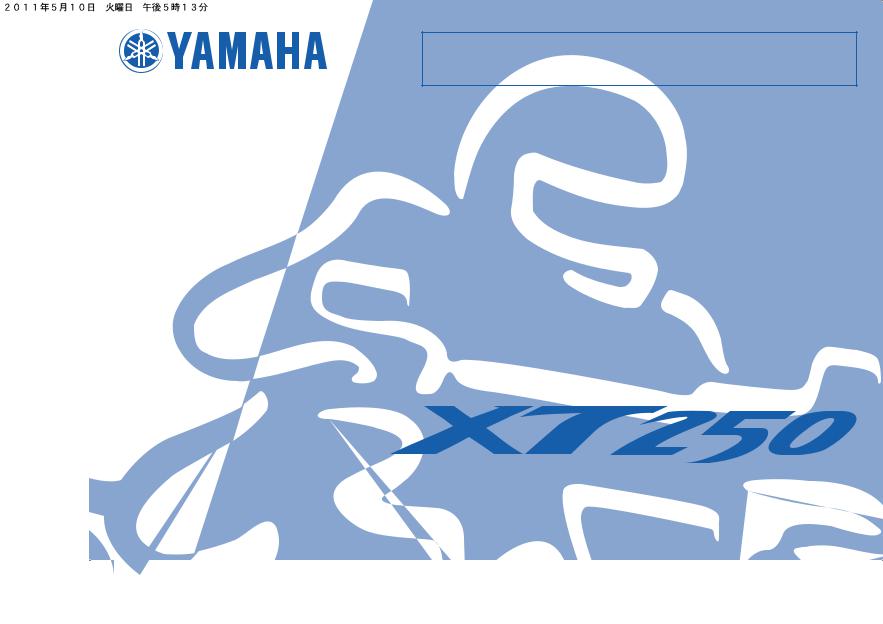
 Read this manual carefully before operating this vehicle.
Read this manual carefully before operating this vehicle.
OWNER’S MANUAL
XT250B
3C5-28199-24

EAU46090
Q Read this manual carefully before operating this vehicle. This manual should stay with this vehicle if it is sold.
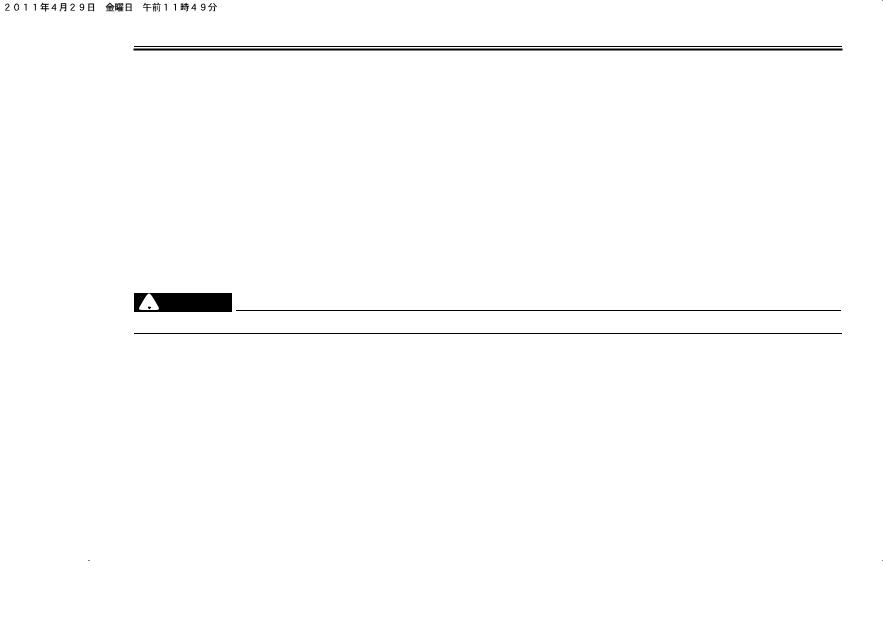
INTRODUCTION
EAU10102
Welcome to the Yamaha world of motorcycling!
As the owner of the XT250B, you are benefiting from Yamaha’s vast experience and newest technology regarding the design and manufacture of high-quality products, which have earned Yamaha a reputation for dependability.
Please take the time to read this manual thoroughly, so as to enjoy all advantages of your XT250B. The Owner’s Manual does not only instruct you in how to operate, inspect and maintain your motorcycle, but also in how to safeguard yourself and others from trouble and injury.
In addition, the many tips given in this manual will help keep your motorcycle in the best possible condition. If you have any further questions, do not hesitate to contact your Yamaha dealer.
The Yamaha team wishes you many safe and pleasant rides. So, remember to put safety first!
Yamaha continually seeks advancements in product design and quality. Therefore, while this manual contains the most current product information available at the time of printing, there may be minor discrepancies between your motorcycle and this manual. If there is any question concerning this manual, please consult a Yamaha dealer.
EWA10031
 WARNING
WARNING
Please read this manual carefully and completely before operating this motorcycle.
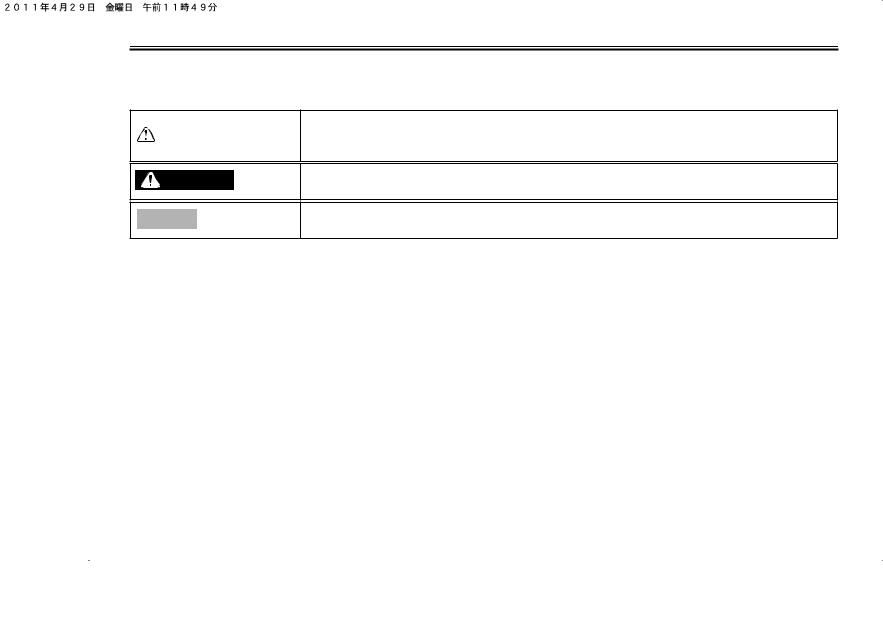
IMPORTANT MANUAL INFORMATION
EAU10132
Particularly important information is distinguished in this manual by the following notations:
This is the safety alert symbol. It is used to alert you to potential personal injury hazards. Obey all safety messages that follow this symbol to avoid possible injury or death.
WARNING
A WARNING indicates a hazardous situation which, if not avoided, could result in death or serious injury.
NOTICE
A NOTICE indicates special precautions that must be taken to avoid damage to the vehicle or other property.
|
|
|
|
|
TIP |
|
A TIP provides key information to make procedures easier or clearer. |
|
|
|
|

IMPORTANT MANUAL INFORMATION
EAU10200
XT250B
OWNER’S MANUAL ©2011 by Yamaha Motor Co., Ltd.
1st edition, April 2011 All rights reserved.
Any reprinting or unauthorized use without the written permission of Yamaha Motor Co., Ltd.
is expressly prohibited. Printed in Japan.

TABLE OF CONTENTS
LOCATION OF IMPORTANT |
|
LABELS .............................................. |
1-1 |
SAFETY INFORMATION ................... |
2-1 |
DESCRIPTION ................................... |
3-1 |
Left view ........................................... |
3-1 |
Right view ......................................... |
3-2 |
Controls and instruments.................. |
3-3 |
INSTRUMENT AND CONTROL |
|
FUNCTIONS ........................................ |
4-1 |
Main switch/steering lock ................. |
4-1 |
Indicator lights ................................. |
4-2 |
Multi-function display ....................... |
4-3 |
Handlebar switches ......................... |
4-4 |
Clutch lever ...................................... |
4-5 |
Shift pedal ........................................ |
4-5 |
Brake lever ...................................... |
4-6 |
Brake pedal ..................................... |
4-6 |
Fuel tank cap ................................... |
4-6 |
Fuel .................................................. |
4-7 |
Fuel cock ......................................... |
4-8 |
Starter (choke) knob ......................... |
4-9 |
Seat ............................................... |
4-10 |
Helmet holder ................................ |
4-10 |
Adjusting the shock absorber |
|
assembly .................................... |
4-11 |
Sidestand ....................................... |
4-12 |
Ignition circuit cut-off system ......... |
4-13 |
FOR YOUR SAFETY – |
|
PRE-OPERATION CHECKS .............. |
5-1 |
OPERATION AND IMPORTANT |
|
RIDING POINTS.................................. |
6-1 |
Starting and warming up a cold |
|
engine .......................................... |
6-1 |
Starting a warm engine ................... |
6-2 |
Shifting ............................................ |
6-2 |
Tips for reducing fuel |
|
consumption ................................ |
6-3 |
Engine break-in ............................... |
6-3 |
Parking ............................................ |
6-4 |
PERIODIC MAINTENANCE AND |
|
ADJUSTMENT .................................... |
7-1 |
Owner’s tool kit ................................ |
7-2 |
Periodic maintenance chart for |
|
the emission control system ........ |
7-3 |
General maintenance and |
|
lubrication chart ........................... |
7-4 |
Removing and installing the |
|
cowling and panels ...................... |
7-8 |
Checking the spark plug ................ |
7-10 |
Engine oil and oil filter element ..... |
7-12 |
Replacing the air filter element |
|
and cleaning the check hose ..... |
7-14 |
Adjusting the carburetor ................ |
7-16 |
Adjusting the engine idling |
|
speed ......................................... |
7-16 |
Checking the throttle grip free |
|
play ............................................ |
7-17 |
Valve clearance ............................ |
7-17 |
Tires .............................................. |
7-17 |
Spoke wheels ............................... |
7-19 |
Adjusting the clutch lever free |
|
play ............................................ |
7-20 |
Adjusting the brake lever free |
|
play ............................................ |
7-20 |
Brake light switches ...................... |
7-21 |
Checking the front and rear |
|
brake pads ................................. |
7-21 |
Checking the brake fluid level ....... |
7-22 |
Changing the brake fluid ............... |
7-23 |
Drive chain slack ........................... |
7-23 |
Cleaning and lubricating the |
|
drive chain ................................. |
7-25 |
Checking and lubricating the |
|
cables ........................................ |
7-25 |
Checking and lubricating the |
|
throttle grip and cable ................ |
7-26 |
Checking and lubricating the |
|
brake and shift pedals ............... |
7-26 |
Checking and lubricating the |
|
brake and clutch levers .............. |
7-27 |
Checking and lubricating the |
|
sidestand ................................... |
7-27 |
Lubricating the rear suspension .... |
7-28 |
Checking the front fork .................. |
7-28 |
Checking the steering ................... |
7-29 |
Checking the wheel bearings ........ |
7-29 |
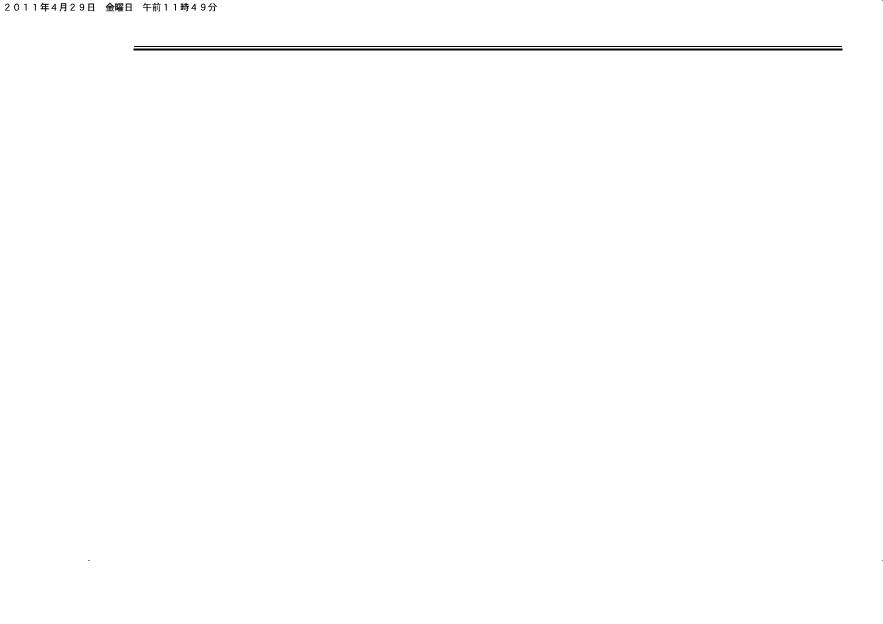
TABLE OF CONTENTS
Battery ........................................... |
7-30 |
Replacing the fuse ......................... |
7-31 |
Replacing the headlight bulb ......... |
7-32 |
Replacing the tail/brake light |
|
bulb ............................................ |
7-33 |
Replacing a turn signal light |
|
bulb ............................................ |
7-34 |
Supporting the motorcycle ............. |
7-34 |
Front wheel .................................... |
7-35 |
Rear wheel .................................... |
7-36 |
Troubleshooting ............................. |
7-38 |
Troubleshooting chart .................... |
7-39 |
MOTORCYCLE CARE AND |
|
STORAGE ........................................... |
8-1 |
Matte color caution .......................... |
8-1 |
Care ................................................. |
8-1 |
Storage ............................................ |
8-3 |
SPECIFICATIONS .............................. |
9-1 |
CONSUMER INFORMATION............ |
10-1 |
Identification numbers ................... |
10-1 |
Motorcycle noise regulation |
|
(for Australia) .............................. |
10-2 |
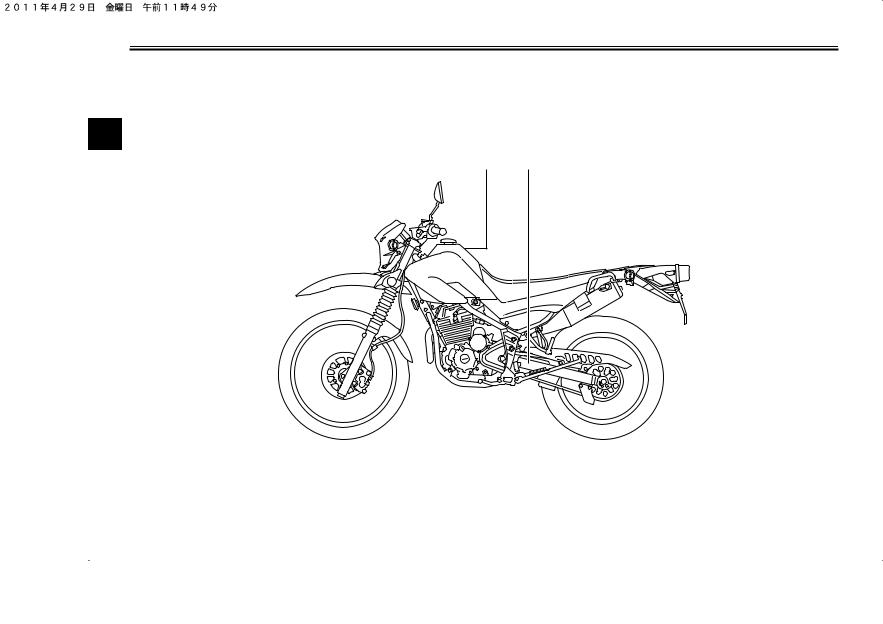
LOCATION OF IMPORTANT LABELS
EAU10384
Read and understand all of the labels on your vehicle. They contain important information for safe and proper operation of your vehicle. Never remove any labels from your vehicle. If a label becomes difficult to read or comes off, a replacement label
1 is available from your Yamaha dealer.
1 2
1-1

LOCATION OF IMPORTANT LABELS
1
2
1
WARNING
 BEFORE YOU OPERATE THIS VEHICLE, READ
BEFORE YOU OPERATE THIS VEHICLE, READ
THE OWNER’S MANUAL AND ALL LABELS.
 ALWAYS WEAR AN APPROVED MOTORCYCLE
ALWAYS WEAR AN APPROVED MOTORCYCLE
HELMET, eye protection, and protective clothing.
5GK-2118K-00
Cold tire normal pressure should be set as follows.
Up to 90 kg (198 Ibs) load |
|
||
FRONT : 125 |
kPa, ( 1.25 kgf / cm2 ), 18 |
psi |
|
REAR |
: 150 |
kPa, ( 1.50 kgf / cm2 ), 22 |
psi |
90 kg (198 Ibs) ~ maximum load |
|
||
FRONT : 150 |
kPa, ( 1.50 kgf / cm2 ), 22 |
psi |
|
REAR |
: 175 |
kPa, ( 1.75 kgf / cm2 ), 25 |
psi |
|
|
3C5-21668-00 |
|
1-2

LOCATION OF IMPORTANT LABELS
1 |
2 |
3 |
1
1-3

LOCATION OF IMPORTANT LABELS
1 |
|
|
|
3 |
STATIONARY NOISE TEST INFORMATION |
1 |
|
|
|
||||
|
||||||
|
|
|
|
|
|
|
|
|
|
|
|
TESTED 80 dB(A) AT 3750 r/min |
|
|
|
|
|
|
|
|
|
|
|
|
|
SILENCING SYSTEM : YAMAHA |
|
|
|
|
|
|
IDENTIFICATION : 5XT |
|
|
|
|
|
|
3C5-2118G-10 |
|
2
4AA-22259-40
1-4

 SAFETY INFORMATION
SAFETY INFORMATION
EAU1031A
Be a Responsible Owner
As the vehicle’s owner, you are responsible for the safe and proper operation
2
of your motorcycle.
Motorcycles are single-track vehicles. Their safe use and operation are dependent upon the use of proper riding techniques as well as the expertise of the operator. Every operator should know the following requirements before riding this motorcycle.
He or she should:
●Obtain thorough instructions from a competent source on all aspects of motorcycle operation.
●Observe the warnings and maintenance requirements in this Owner’s Manual.
●Obtain qualified training in safe and proper riding techniques.
●Obtain professional technical service as indicated in this Owner’s Manual and/or when made necessary by mechanical conditions.
Safe Riding
Perform the pre-operation checks each time you use the vehicle to make sure it is in safe operating condition. Failure to inspect or maintain the vehicle properly increases the possibility of an accident or equipment damage. See page 5-1 for a list of pre-operation checks.
●This motorcycle is designed to carry the operator and a passenger.
●The failure of motorists to detect and recognize motorcycles in traffic is the predominating cause of automobile/motorcycle accidents. Many accidents have been caused by an automobile driver who did not see the motorcycle. Making yourself conspicuous appears to be very effective in reducing the chance of this type of accident.
Therefore:
•Wear a brightly colored jacket.
•Use extra caution when you are approaching and passing through intersections, since intersections are the most likely places for motorcycle accidents to occur.
•Ride where other motorists can see you. Avoid riding in another motorist’s blind spot.
●Many accidents involve inexperienced operators. In fact, many operators who have been involved in accidents do not even have a current motorcycle license.
•Make sure that you are qualified and that you only lend your motorcycle to other qualified operators.
•Know your skills and limits. Staying within your limits may help you to avoid an accident.
•We recommend that you practice riding your motorcycle where there is no traffic until you have become thoroughly familiar with the motorcycle and all of its controls.
●Many accidents have been caused by error of the motorcycle operator. A typical error made by the operator is veering wide on a turn due to excessive speed or undercornering (insufficient lean angle for the speed).
2-1
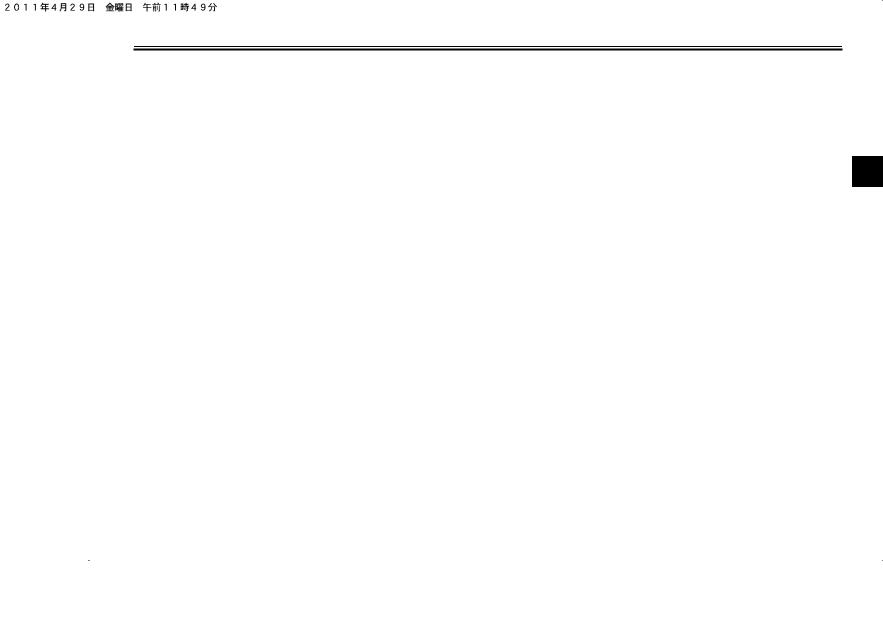
 SAFETY INFORMATION
SAFETY INFORMATION
•Always obey the speed limit and never travel faster than warranted by road and traffic conditions.
•Always signal before turning or changing lanes. Make sure that other motorists can see you.
●The posture of the operator and passenger is important for proper control.
•The operator should keep both hands on the handlebar and both feet on the operator footrests during operation to maintain control of the motorcycle.
•The passenger should always hold onto the operator, the seat strap or grab bar, if equipped, with both hands and keep both feet on the passenger footrests. Never carry a passenger unless he or she can firmly place both feet on the passenger footrests.
●Never ride under the influence of alcohol or other drugs.
Protective Apparel
The majority of fatalities from motorcycle accidents are the result of head in-
juries. The use of a safety helmet is the single most critical factor in the prevention or reduction of head injuries.
●Always wear an approved helmet.
●Wear a face shield or goggles. Wind in your unprotected eyes could contribute to an impairment of vision that could delay seeing a hazard.
●The use of a jacket, heavy boots, trousers, gloves, etc., is effective in preventing or reducing abrasions or lacerations.
●Never wear loose-fitting clothes, otherwise they could catch on the control levers, footrests, or wheels and cause injury or an accident.
●Always wear protective clothing that covers your legs, ankles, and feet. The engine or exhaust system become very hot during or after operation and can cause burns.
●A passenger should also observe the above precautions.
Avoid Carbon Monoxide Poisoning
All engine exhaust contains carbon monoxide, a deadly gas. Breathing car-
bon monoxide can cause headaches, dizziness, drowsiness, nausea, confusion, and eventually death.
Carbon Monoxide is a colorless, odorless, tasteless gas which may be present even if you do not see or smell
any engine exhaust. Deadly levels of 2 carbon monoxide can collect rapidly
and you can quickly be overcome and unable to save yourself. Also, deadly levels of carbon monoxide can linger for hours or days in enclosed or poorly ventilated areas. If you experience any symptoms of carbon monoxide poisoning, leave the area immediately, get fresh air, and SEEK MEDICAL TREATMENT.
●Do not run engine indoors. Even if you try to ventilate engine exhaust with fans or open windows and doors, carbon monoxide can rapidly reach dangerous levels.
●Do not run engine in poorly ventilated or partially enclosed areas such as barns, garages, or carports.
●Do not run engine outdoors where engine exhaust can be drawn into
2-2

 SAFETY INFORMATION
SAFETY INFORMATION
|
|
a building through openings such |
should be kept as low and close to |
|||||
|
|
as windows and doors. |
the motorcycle as possible. Se- |
|||||
|
|
|
|
curely pack your heaviest items as |
||||
|
|
Loading |
close to the center of the vehicle as |
|||||
|
|
Adding accessories or cargo to your |
possible and make sure to distrib- |
|||||
|
|
motorcycle can adversely affect stabili- |
ute the weight as evenly as possi- |
|||||
2 |
|
ty and handling if the weight distribution |
ble on both sides of the motorcycle |
|||||
|
of the motorcycle is changed. To avoid |
to minimize imbalance or instabili- |
||||||
|
|
|||||||
|
|
the possibility of an accident, use ex- |
ty. |
|
|
|
|
|
|
|
treme caution when adding cargo or |
● Shifting weights can create a sud- |
|||||
|
|
accessories to your motorcycle. Use |
den imbalance. Make sure that ac- |
|||||
|
|
extra care when riding a motorcycle |
cessories and cargo are securely |
|||||
|
|
that has added cargo or accessories. |
attached to the motorcycle before |
|||||
|
|
Here, along with the information about |
riding. Check accessory mounts |
|||||
|
|
accessories below, are some general |
and cargo restraints frequently. |
|||||
|
|
guidelines to follow if loading cargo to |
• Properly adjust the suspension |
|||||
|
|
your motorcycle: |
for your load (suspension-ad- |
|||||
|
|
The total weight of the operator, pas- |
justable |
models |
only), |
and |
||
|
|
senger, accessories and cargo must |
check the condition and pres- |
|||||
|
|
not exceed the maximum load limit. |
sure of your tires. |
|
|
|||
|
|
Operation of an overloaded vehicle |
• Never attach any large or heavy |
|||||
|
|
could cause an accident. |
items to the handlebar, front |
|||||
|
|
|
|
fork, |
or |
front fender. |
These |
|
|
|
Maximum load: |
|
|||||
|
|
|
items, including such cargo as |
|||||
|
|
151 kg (333 lb) |
|
|||||
|
|
|
sleeping bags, duffel bags, or |
|||||
|
|
|
|
|||||
|
|
When loading within this weight limit, |
tents, can create unstable han- |
|||||
|
|
dling |
or |
a slow |
steering re- |
|||
|
|
keep the following in mind: |
||||||
|
|
|
|
|
|
|
||
● Cargo and accessory weight |
sponse. |
|
●This vehicle is not designed to pull a trailer or to be attached to a sidecar.
Genuine Yamaha Accessories
Choosing accessories for your vehicle is an important decision. Genuine Yamaha accessories, which are available only from a Yamaha dealer, have been designed, tested, and approved by Yamaha for use on your vehicle.
Many companies with no connection to Yamaha manufacture parts and accessories or offer other modifications for Yamaha vehicles. Yamaha is not in a position to test the products that these aftermarket companies produce. Therefore, Yamaha can neither endorse nor recommend the use of accessories not sold by Yamaha or modifications not specifically recommended by Yamaha, even if sold and installed by a Yamaha dealer.
Aftermarket Parts, Accessories, and Modifications
While you may find aftermarket products similar in design and quality to
2-3

 SAFETY INFORMATION
SAFETY INFORMATION
genuine Yamaha accessories, recognize that some aftermarket accessories or modifications are not suitable because of potential safety hazards to you or others. Installing aftermarket products or having other modifications performed to your vehicle that change any of the vehicle’s design or operation characteristics can put you and others at greater risk of serious injury or death. You are responsible for injuries related to changes in the vehicle.
Keep the following guidelines in mind, as well as those provided under “Loading” when mounting accessories.
●Never install accessories or carry cargo that would impair the performance of your motorcycle. Carefully inspect the accessory before using it to make sure that it does not in any way reduce ground clearance or cornering clearance, limit suspension travel, steering travel or control operation, or obscure lights or reflectors.
•Accessories fitted to the handlebar or the front fork area can create instability due to improper
weight distribution or aerodynamic changes. If accessories are added to the handlebar or front fork area, they must be as lightweight as possible and should be kept to a minimum.
•Bulky or large accessories may seriously affect the stability of the motorcycle due to aerodynamic effects. Wind may attempt to lift the motorcycle, or the motorcycle may become unstable in cross winds. These accessories may also cause instability when passing or being passed by large vehicles.
•Certain accessories can displace the operator from his or her normal riding position. This improper position limits the freedom of movement of the operator and may limit control ability, therefore, such accessories are not recommended.
●Use caution when adding electrical accessories. If electrical accessories exceed the capacity of the motorcycle’s electrical system, an
electric failure could result, which could cause a dangerous loss of lights or engine power.
Aftermarket Tires and Rims
The tires and rims that came with your motorcycle were designed to match the 2 performance capabilities and to provide
the best combination of handling, braking, and comfort. Other tires, rims, sizes, and combinations may not be appropriate. Refer to page 7-17 for tire specifications and more information on replacing your tires.
Transporting the Motorcycle
Be sure to observe following instructions before transporting the motorcycle in another vehicle.
●Remove all loose items from the motorcycle.
●Check that the fuel cock (if equipped) is in the “OFF” position and that there are no fuel leaks.
●Point the front wheel straight ahead on the trailer or in the truck bed, and choke it in a rail to prevent movement.
2-4

 SAFETY INFORMATION
SAFETY INFORMATION
●Shift the transmission in gear (for models with a manual transmission).
●Secure the motorcycle with tie-downs or suitable straps that are attached to solid parts of the
2motorcycle, such as the frame or upper front fork triple clamp (and not, for example, to rubber-mount- ed handlebars or turn signals, or parts that could break). Choose the location for the straps carefully so the straps will not rub against painted surfaces during transport.
●The suspension should be compressed somewhat by the tie-downs, if possible, so that the motorcycle will not bounce excessively during transport.
2-5
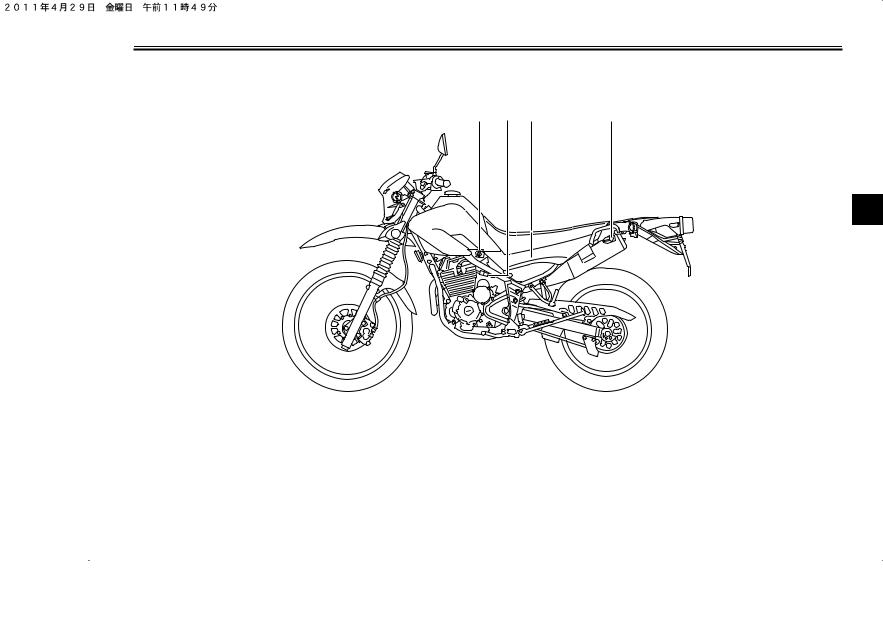
DESCRIPTION
EAU10410
Left view
1 |
2 |
3 |
4 |
3
1.Fuel cock (page 4-8)
2.Starter (choke) knob (page 4-9)
3.Air filter element (page 7-14)
4.Helmet holder (page 4-10)
3-1

DESCRIPTION
EAU10420
Right view
1 |
2 |
3 |
3
5 4
1.Battery (page 7-30)
2.Fuse (page 7-31)
3.Owner’s tool kit (page 7-2)
4.Engine oil level check window (page 7-12)
5.Engine oil filler bolt (page 7-12)
3-2

DESCRIPTION
EAU10430
Controls and instruments
1 |
2 |
3 |
4 |
5 |
6 |
7 |
8 |
3
9
1. |
Clutch lever (page 4-5) |
8. |
Throttle grip (page 7-17) |
2. |
Left handlebar switches (page 4-4) |
9. |
Fuel tank cap (page 4-6) |
3.Indicator lights (page 4-2)
4.Main switch/steering lock (page 4-1)
5.Multi-function display (page 4-3)
6.Right handlebar switches (page 4-4)
7.Brake lever (page 4-6)
3-3

INSTRUMENT AND CONTROL FUNCTIONS
EAU10460
Main switch/steering lock
4The main switch/steering lock controls the ignition and lighting systems, and is used to lock the steering. The various positions are described below.
EAU45110
ON
All electrical circuits are supplied with power, and the meter lighting and taillight come on, and the engine can be started. The key cannot be removed.
TIP
The headlight comes on automatically when the engine is started and stays on until the key is turned to “OFF”, even if the engine stalls.
EAU10661
OFF
All electrical systems are off. The key can be removed.
EWA10061
 WARNING
WARNING
Never turn the key to “OFF” or “LOCK” while the vehicle is moving. Otherwise the electrical systems will be switched off, which may result in loss of control or an accident.
EAU10691
LOCK
The steering is locked, and all electrical systems are off. The key can be removed.
To lock the steering
1
2
1.Push.
2.Turn.
1.Turn the handlebars all the way to the left or right.
2.Push the key in from the “OFF” position, and then turn it to “LOCK” while still pushing it.
3.Remove the key.
4-1
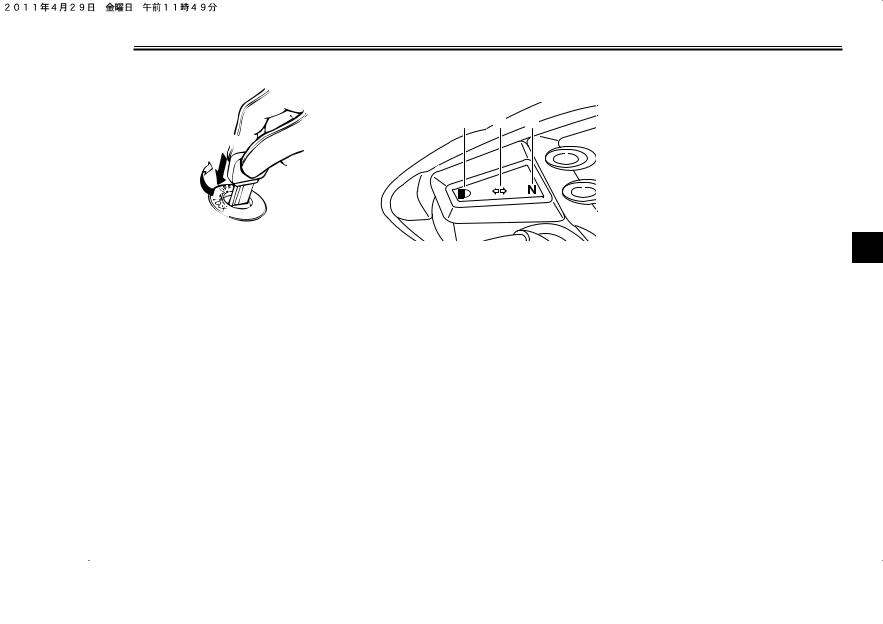
INSTRUMENT AND CONTROL FUNCTIONS
To unlock the steering
1 
2
1.Push.
2.Turn.
Push the key into the main switch, and then turn it to “OFF” while still pushing it.
EAU10981
Indicator lights
1 |
2 |
3 |
1.High beam indicator light “  ”
”
2.Turn signal indicator light “  ”
”
3.Neutral indicator light “  ”
”
EAU11020
Turn signal indicator light “ ”
”
This indicator light flashes when the turn signal switch is pushed to the left or right.
EAU11060
Neutral indicator light “ ”
”
This indicator light comes on when the transmission is in the neutral position.
EAU11080
High beam indicator light “ ”
”
This indicator light comes on when the
high beam of the headlight is switched on.
4
4-2

INSTRUMENT AND CONTROL FUNCTIONS
EAU44873
Multi-function display
EWA12312
 WARNING
WARNING
Be sure to stop the vehicle before making any setting changes to the multi-function display. Changing settings while riding can distract the operator and increase the risk of an accident.
4 |
1 |
2 |
3 |
4 |
1.“SELECT” button
2.“RESET” button
3.Clock
4.Speedometer
1 |
2 |
1.Odometer/tripmeter (bottom)
2.Tripmeter (top)
The multi-function display is equipped with the following:
●a speedometer
●an odometer
●two tripmeters (which show the distance traveled since they were last set to zero)
●a clock
TIP
●Be sure to turn the key to “ON” before using the “SELECT” and “RESET” buttons.
●When the key is turned to “ON”, all of the display segments of the multi-function display will appear one after the other and then disap-
pear, in order to test the electrical circuit.
Odometer, clock and tripmeter modes
Pushing the “SELECT” button switches the display between the odometer mode “ODO” and the tripmeter modes “TRIP” in the following order:
ODO → TRIP (top) → TRIP (bottom) → ODO
To reset a tripmeter, select it by pushing the “SELECT” button until “TRIP” begins flashing (“TRIP” will only flash for five seconds). While “TRIP” is flashing, push the “RESET” button for at least one second.
Clock mode
To set the clock:
1.Push the “SELECT” button and “RESET” button together for at least two seconds.
2.When the hour digits start flashing, push the “RESET” button to set the hours.
3.Push the “SELECT” button, and
4-3
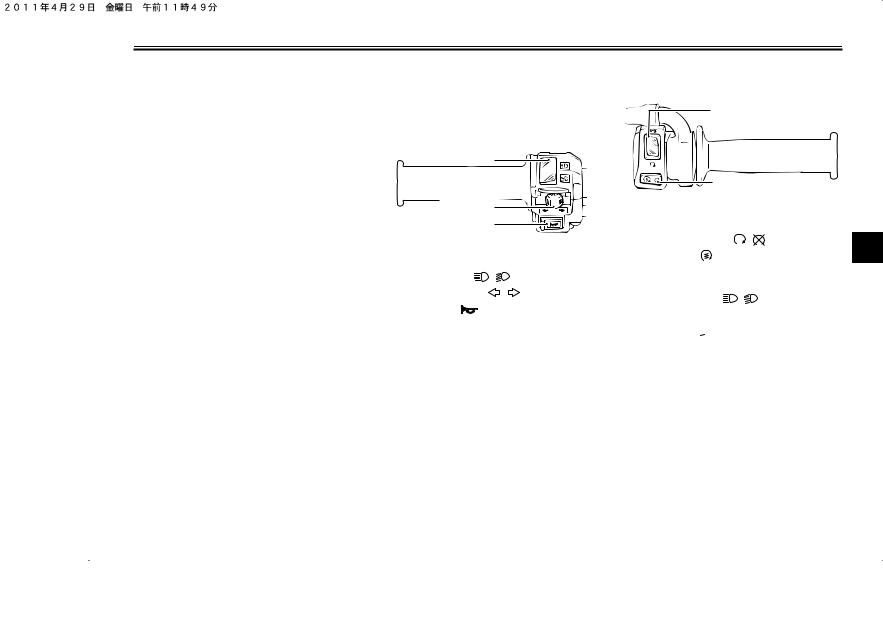
INSTRUMENT AND CONTROL FUNCTIONS
the minute digits will start flashing.
4.Push the “RESET” button to set the minutes.
5.Push the “SELECT” button and then release it to start the clock.
EAU12348
Handlebar switches
Left |
|
|
|
|
|
|
1 |
|
|
|
|
2 |
|
|
|
|
3 |
|
|
1. |
Dimmer switch “ |
/ |
|
” |
2. |
Turn signal switch “ |
/ |
” |
|
3. |
Horn switch “ |
” |
|
|
Right |
|
|
|
|
|
|
|
1 |
|
|
|
|
|
2 |
|
|
|
1. |
Engine stop switch “ |
/ |
” |
4 |
|
2. |
Start switch “ |
” |
|
|
|
|
|
|
|||
|
|
|
|
|
EAU12400 |
Dimmer switch “ |
/ |
” |
|
||
Set this switch to “ ” for the high beam and to “
” for the high beam and to “ ” for the low beam.
” for the low beam.
EAU12460
Turn signal switch “ /
/ ”
”
To signal a right-hand turn, push this switch to “ ”. To signal a left-hand turn, push this switch to “
”. To signal a left-hand turn, push this switch to “ ”. When released, the switch returns to the center position. To cancel the turn signal lights, push the switch in after it has returned to the center position.
”. When released, the switch returns to the center position. To cancel the turn signal lights, push the switch in after it has returned to the center position.
4-4
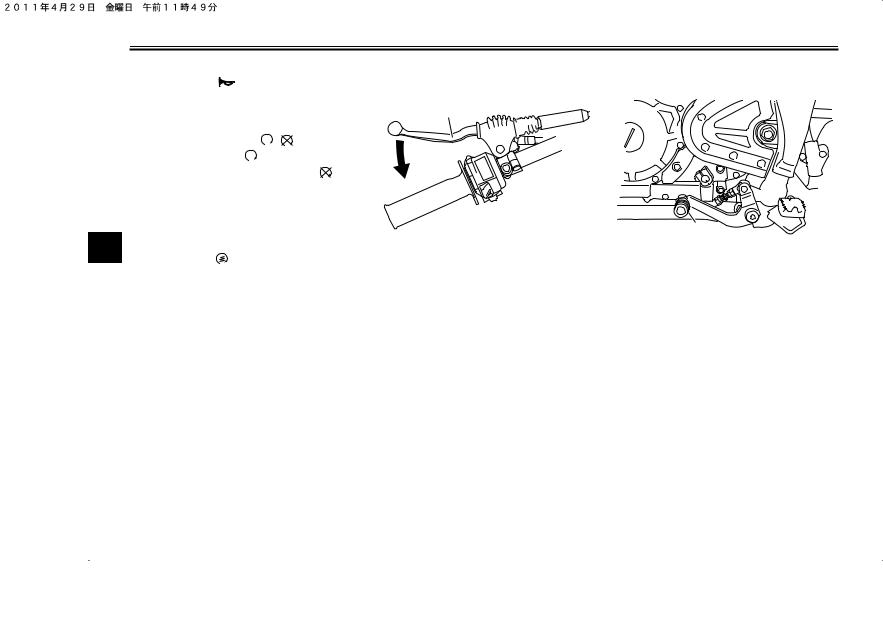
INSTRUMENT AND CONTROL FUNCTIONS
EAU12500 |
EAU12820 |
Horn switch “ ” |
Clutch lever |
Press this switch to sound the horn. |
||
|
|
1 |
|
|
EAU12660 |
Engine stop switch “ |
/ |
” |
Set this switch to “ ” before starting |
||
the engine. Set this switch to “ ” to |
||
stop the engine in case of an emergen- |
||
cy, such as when the vehicle overturns |
||
or when the throttle cable is stuck. |
||
4 |
EAU12711 |
1. Clutch lever |
|
Start switch “ |
” |
||
|
|||
Push this switch to crank the engine |
The clutch lever is located at the left |
||
with the starter. See page 6-1 for start- |
handlebar grip. To disengage the |
||
ing instructions prior to starting the en- |
clutch, pull the lever toward the handle- |
||
gine. |
|
bar grip. To engage the clutch, release |
|
|
|
the lever. The lever should be pulled |
|
|
|
rapidly and released slowly for smooth |
|
|
|
clutch operation. |
|
|
|
The clutch lever is equipped with a |
|
|
|
clutch switch, which is part of the igni- |
|
|
|
tion circuit cut-off system. (See |
|
|
|
page 4-13.) |
|
EAU12871
Shift pedal
1 |
1. Shift pedal
The shift pedal is located on the left side of the motorcycle and is used in combination with the clutch lever when shifting the gears of the 5-speed con- stant-mesh transmission equipped on this motorcycle.
4-5

INSTRUMENT AND CONTROL FUNCTIONS
EAU12890
Brake lever
1 |
1. Brake lever
The brake lever is located at the right handlebar grip. To apply the front brake, pull the lever toward the handlebar grip.
EAU12941
Brake pedal
1 |
1. Brake pedal
The brake pedal is on the right side of the motorcycle. To apply the rear brake, press down on the brake pedal.
EAUM1793
Fuel tank cap
To remove the fuel tank cap
1.Open the fuel tank cap lock cover.
2.Insert the key into the lock and turn it 1/4 turn clockwise. The lock will be released and the fuel tank cap can be removed.
2 |
4 |
|
1 |
1.Fuel tank cap lock cover
2.Unlock.
To install the fuel tank cap
1.Push and install the fuel tank cap into position with the key inserted in the lock.
2.Turn the key counterclockwise to the original position, and then remove it.
4-6

INSTRUMENT AND CONTROL FUNCTIONS
TIP
4The fuel tank cap cannot be installed unless the key is in the lock. In addition, the key cannot be removed if the cap is not properly installed and locked.
3.Close the lock cover.
EWA11141
 WARNING
WARNING
Make sure that the fuel tank cap is properly installed before riding. Leaking fuel is a fire hazard.
EAU13212
Fuel
Make sure there is sufficient gasoline in the tank.
EWA10881
 WARNING
WARNING
Gasoline and gasoline vapors are extremely flammable. To avoid fires and explosions and to reduce the risk of injury when refueling, follow these instructions.
1.Before refueling, turn off the engine and be sure that no one is sitting on the vehicle. Never refuel while smoking, or while in the vicinity of sparks, open flames, or other sources of ignition such as the pilot lights of water heaters and clothes dryers.
2.Do not overfill the fuel tank. Stop filling when the fuel reaches the bottom of the filler tube. Because fuel expands when it heats up, heat from the engine or the sun can cause fuel to spill out of the fuel tank.
2 |
1 |
1.Maximum fuel level
2.Fuel tank filler tube
3.Wipe up any spilled fuel immediately. NOTICE: Immediately wipe off spilled fuel with a clean, dry, soft cloth, since fuel may deteriorate painted surfaces or plastic
parts.[ECA10071]
4.Be sure to securely close the fuel tank cap.
EWA15151
 WARNING
WARNING
Gasoline is poisonous and can cause injury or death. Handle gasoline with care. Never siphon gasoline by mouth. If you should swallow some gasoline or inhale a lot of gasoline vapor, or get some gasoline in
4-7
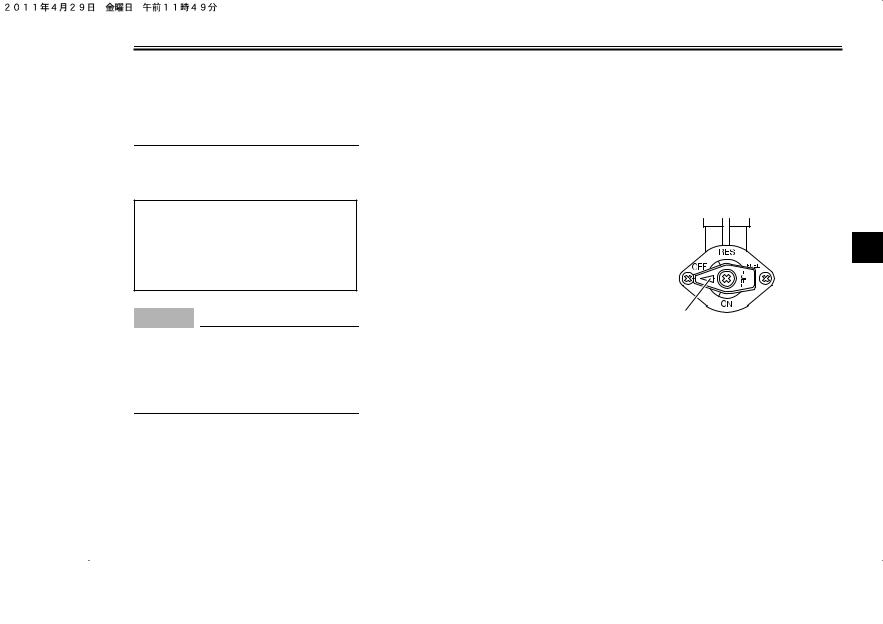
INSTRUMENT AND CONTROL FUNCTIONS
your eyes, see your doctor immediately. If gasoline spills on your skin, wash with soap and water. If gasoline spills on your clothing, change your clothes.
EAU13321
leaded fuel will extend spark plug life and reduce maintenance costs.
Recommended fuel:
Unleaded gasoline only
Fuel tank capacity:
10.0 L (2.64 US gal, 2.20 Imp.gal)
Fuel reserve amount:
1.9 L (0.50 US gal, 0.42 Imp.gal)
ECA11400
NOTICE
Use only unleaded gasoline. The use of leaded gasoline will cause severe damage to internal engine parts, such as the valves and piston rings, as well as to the exhaust system.
Your Yamaha engine has been designed to use regular unleaded gasoline with a research octane number of 91 or higher. If knocking (or pinging) occurs, use a gasoline of a different brand or premium unleaded fuel. Use of un-
EAU13561
Fuel cock
The fuel cock supplies fuel from the tank to the carburetor while filtering it also.
The fuel cock has three positions:
OFF
4
1
1. Pointed end positioned under “OFF”
With the lever in this position, fuel will not flow. Always return the lever to this position when the engine is not running.
4-8

INSTRUMENT AND CONTROL FUNCTIONS
ON
|
1 |
4 |
1. Pointed end positioned over “ON” |
With the lever in this position, fuel flows to the carburetor. Normal riding is done with the lever in this position.
RES
1
This indicates reserve. If you run out of fuel while riding, move the lever to this position. Fill the tank at the first opportunity. Be sure to set the lever back to “ON” after refueling!
EAU13600
Starter (choke) knob “ 

 ”
”
|
|
1 |
|
|
(a) |
(b) |
|
1. |
Starter (choke) knob “ |
” |
|
Starting a cold engine requires a richer air-fuel mixture, which is supplied by the starter (choke).
Move the knob in direction (a) to turn on the starter (choke).
Move the knob in direction (b) to turn off the starter (choke).
1. Pointed end positioned over “RES”
4-9
